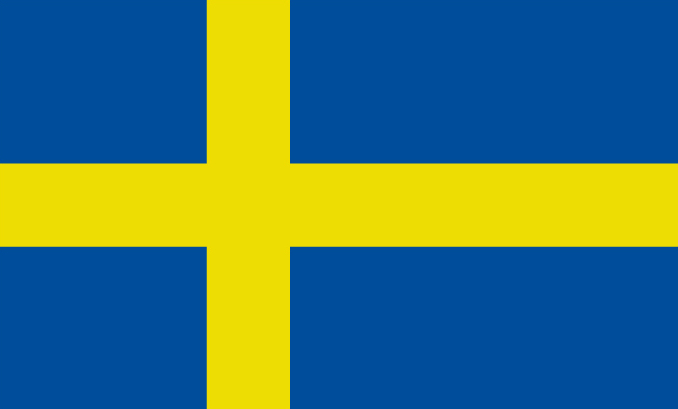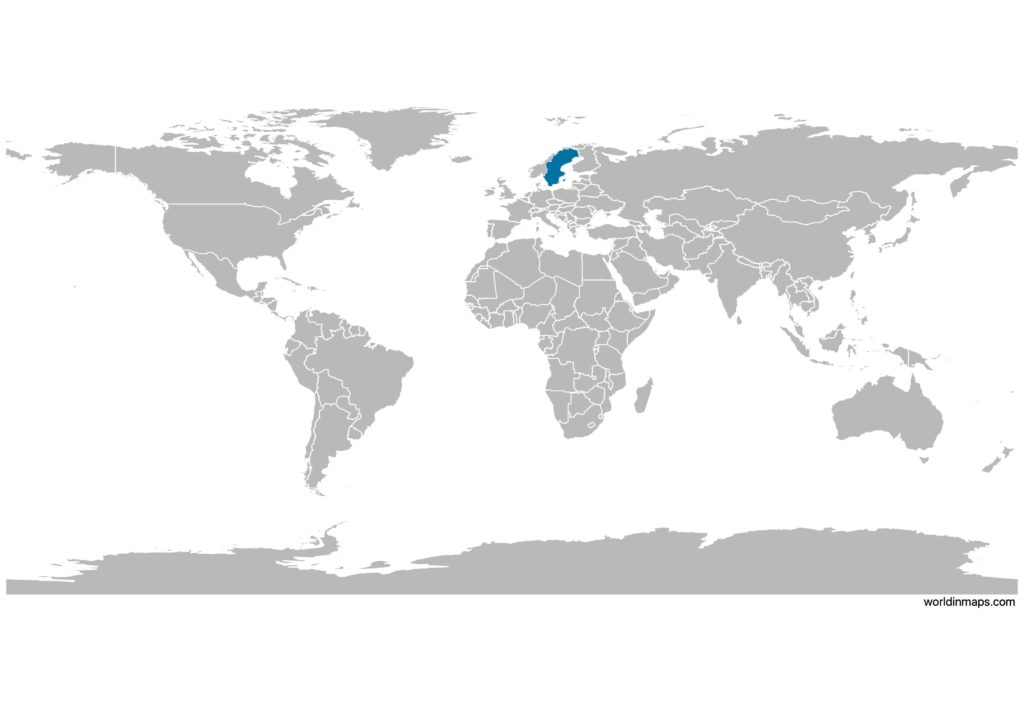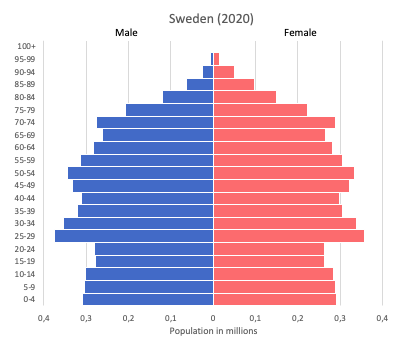Sweden

| Government | |
| Name | Kingdom of Sweden |
| Swedish | Konungariket Sverige |
| Government type | parliamentary constitutional monarchy |
| Capital | Stockholm (952,058 (2017)) |
| Currency | Swedish krona (SEK) |
| People | |
| Population (2020) | 10,099,270 (89th) |
| Density of population | 23 P/km2 (198th) |
| Nationality | Swedish |
| Official languages | |
| Swedish | |
| Ethnic groups (2018) | |
| Swedish | 80.9% |
| Syrian | 1.8% |
| Finnish | 1.4% |
| Iraqi | 1.4% |
| other | 14.5% |
| Religions (2017) | |
| Church of Sweden (Lutheran) | 60.2% |
| other | 8.5% |
| none or unspecified | 31.3% |
| Life expectancy (2020) | |
| Male | 80.4 years |
| Female | 84.5 years |
| Total population | 82.4 years (18th) |
| Homicides | |
| Total (2018) | 1.1 per 100,000 people (139th) |
| Geography | |
| Land area | 410,335 km2 |
| water area | 39,960 km2 |
| total area | 450,295 km2 (57th) |
| Mean elevation | 320 m |
| Lowest point | |
| reclaimed bay of Lake Hammarsjon, near Kristianstad | -2.4 m |
| Highest point | |
| Kebnekaise | 2,111 m |
| Land use (2011) | |
| Agricultural land | 7.5% |
| Arable land | 6.4% |
| Permanent crops | 0% |
| Permanent pasture | 1.1% |
| Forest | 68.7% |
| Other | 23.8% |
| Urbanization | |
| Urban population (2020) | 88% |
| Rate of urbanization | 1.05% annual rate of change (2015 – 2020) |
| Economy | |
| Labor force (2017) | 5.361 million (77th) |
| Labor force by occupation (2014) | |
| Agriculture | 2% |
| Industry | 12% |
| Services | 86% |
| Unemployment rate (2017) | 6.7% (101st) |
| GDP (PPP) (estimate 2019) | |
| Total | $563.882 billion (39th) |
| Per capita | $54,628 (15th) |
| GDP (nominal) (estimate 2019) | |
| Total | $528.929 billion (23rd) |
| Per capita | $51,242 (12th) |
| GDP by sector (estimate 2017) | |
| Agriculture | 1.6% |
| Industry | 33% |
| Services | 65.4% |
| Exports (2017) | $165.6 billion (31st) |
| Exports partners (2017) | |
| Germany | 11% |
| Norway | 10.2% |
| Finland | 6.9% |
| US | 6.9% |
| Denmark | 6.9% |
| UK | 6.2% |
| Netherlands | 5.5% |
| China | 4.5% |
| Belgium | 4.4% |
| France | 4.2% |
| Imports (2017) | $153.2 billion (30th) |
| Imports partners (2017) | |
| Germany | 18.7% |
| Netherlands | 8.9% |
| Norway | 7.7% |
| Denmark | 7.2% |
| China | 5.5% |
| UK | 5.1% |
| Finland | 4.7% |
| Belgium | 4.7% |
Sweden on the world map

Sweden is located in the north of Europe and it is part of the region of Scandinavia.
Sweden top 10 largest cities (2017)
- Stockholm (952,058)
- Gothenburg (Göteborg) (565,496)
- Malmö (334,987)
- Uppsala (221,141)
- Linköping (158,953)
- Örebro (150,949)
- Västerås (150,564)
- Helsingborg (143,671)
- Norrköping (140,991)
- Jönköping (137,863)
Demography
Population pyramid

Age structure data
Estimate for 2020:
- 0-14 years: 17.71% (male 928,413/female 878,028)
- 15-24 years: 10.8% (male 569,082/female 532,492)
- 25-54 years: 39.01% (male 2,016,991/female 1,962,617)
- 55-64 years: 11.9% (male 610,521/female 603,795)
- 65 years and over: 20.59% (male 974,410/female 1,126,142)
Remark: the age structure of a population affects a nation’s key socioeconomic issues. Countries with young populations (high percentage under age 15) need to invest more in schools, while countries with older populations (high percentage ages 65 and over) need to invest more in the health sector. The age structure can also be used to help predict potential political issues. For example, the rapid growth of a young adult population unable to find employment can lead to unrest.
Population from 1950 to 2020
Source: United Nations, Department of Economic and Social Affairs, Population Division (2019). World Population Prospects 2019, Online Edition. Rev. 1.
Evolution of the life expectancy from 1960 to 2018
Source: World Development Indicators, The World Bank
Economy
Agriculture:
barley, wheat, sugar beets, meat, milk
Industries:
iron and steel, precision equipment (bearings, radio and telephone parts, armaments), wood pulp and paper products, processed foods, motor vehicles
Exports – commodities:
machinery (26% – 2016), motor vehicles, paper products, pulp and wood, iron and steel products, chemicals
Imports – commodities:
machinery, petroleum and petroleum products, chemicals, motor vehicles, iron and steel, foodstuffs, clothing
Time zone and current time in Sweden
Go to our interactive map to get the current time in Sweden
History
The Kalmar Union (1397 – 1523)